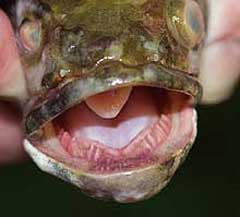Invasive Species
|
Navigation
The estimated damages from invasive species worldwide is enormous, totaling more than 5% of the global economy or 1.4 trillion dollars. In the U.S. alone, damages from invasive species totals $1.1 - 120 billion annually in economic losses. Approximately 42% of threatened or endangered species are at risk due to non-native, invasive species. According to the IUCN Red List, invasive alien species are the fifth most severe threat to amphibians, and the third most severe threat to birds and mammals. |
 Northern Snakehead Fish. Photo: USGS, FISC
Invasive alien species, which can be plants, animals, disease, fungi, parasites, insects, weeds, marine pests or other invertebrates and organisms, are one of the leading and most rapidly growing threats to food security, human and animal health and biodiversity. Invasive species are defined as a species that is non-native or alien to the ecosystem under consideration are are primarily introduced to non-native habitats or areas outside their natural ranges by humans either intentionally or unintentionally, which damages the health and balance of ecosystems that native plants and animals depend on, hurts economies and threatens human well-being. The transportation of these invaders can occur through global travel, transport, tourism and trade, including ships, wood products, ornamental plants and pet trade. It is important to note that species invasions are a vital aspect of nature and have always been present in the history of life on Earth. However, what is of great concern is the extraordinary rate at which the invasions are now taking place. The estimated damages from invasive species worldwide is enormous, totaling more than 5% of the global economy or 1.4 trillion dollars. In the U.S. alone, damages from invasive species totals $1.1 - 120 billion per year in economic losses. The IUCN exemplifies the issue, stating: "Water Hyacinth (Eichnornia crassipes) is an aquatic plant native to the Amazon basin, but in Africa its rapid spread poses a significant threat to water supplies and the use of inland waters for fishing or transportation. The economic impacts may be as much as US$ 100 million annually across all of Africa." Approximately 42% of threatened or endangered species are at risk due to non-native, invasive species. These impacts are second only to habitat loss and degradation as a cause of our current global biodiversity crisis, also known as the sixth mass species extinction crisis. According to the IUCN Red List, invasive alien species are the fifth most severe threat to amphibians, and the third most severe threat to birds and mammals. The National Wildlife Federation explains one of the many ways an invasive species can harm to wildlife and disrupt the stability of ecosystems by stating, "When a new and aggressive species is introduced into an ecosystem, it might not have any natural predators or controls. It can breed and spread quickly, taking over an area. Native wildlife may not have evolved defenses against the invader or they cannot compete with a species that has no predators." Moreover, higher average global temperatures, brought upon by global warming, and changes to rain and snow patterns, is opening up previously inaccessible areas for species to expand to, further accelerating the detrimental effects of invasive species. Learn more.
|
|
Lionfish The Indo-Pacific lionfish, which has become widely established along the Southeast U.S. and Caribbean, has a diet consisting of over 40 species of fish and crustacean species which is making this invasive species a real threat to many native reef fish populations through direct predation as well as competition for food resources. According to ANS Taskforce, "Researchers have reported that within a short period after lionfish are introduced into a new area, survival of native reef fishes declines by about 80 percent. Further, the voracious feeding behavior of the lionfish may impact the abundance of ecologically important species such as parrotfish and other herbivorous fishes that keep seaweeds and macroalgae from overgrowing corals." Lionfish can permanently impact coral reef conservation measures and economically important species, such as snapper and grouper. Photo: Paula Whitfield/NOAA |
Asian Carp After their introduction into the U.S., Asian carp spread quickly, became very abundant and hurt native fish by consuming immense amounts of food or damaging the marine habitat by reducing water quality and uprooting or consuming aquatic vegetation. According to the USDA, "Scientists fear that an Asian carp invasion into the Great Lakes could devastate the region's $7 billion sport and commercial fishery." Asian carp can be found in the Mississippi River drainage basin and Illinois River, however, they have spread or have been introduced legally or illegally into nearly every state in the U.S. and due to their large size and rapid rate of reproduction, they pose a serious threat to the Great Lakes ecosystem. Photo: USGS, FISC Approximately 42% of threatened or endangered species are at risk due to non-native, invasive species. These impacts are second only to habitat loss and degradation as a cause of our current global biodiversity crisis, also known as the sixth mass species extinction crisis. According to the IUCN Red List, invasive alien species are the fifth most severe threat to amphibians, and the third most severe threat to birds and mammals. The estimated damages from invasive species worldwide is enormous, totaling more than 5% of the global economy or 1.4 trillion dollars. In the U.S. alone, damages from invasive species totals $1.1 - 120 billion per year in economic losses. |
Burmese Python The Burmese python, which is among the largest snakes in the world reaching up to 26 feet in length, was imported to the U.S. for the pet trade. When these animals escaped or were intentionally released into the ecosystem, wild populations became established. The Burmese python competes with and preys on native species, some of which are endangered, and has become one of the top predators in the Florida Everglades National Park, with a population between 30,000 and 100,000 snakes, posing a threat to many of the indigenous and endangered species there. Photo: USFWS/Southeast, Flickr |
"Many species introduced into new environments are unable to survive in their new surroundings. However, a percentage of these species are able to expand the area they infest and negatively impact the economy, human health or ecology of a region and are termed invasive. Habitat alteration and invasive species impacts have been the major cause of species extinctions over the past few hundred years, increasing the rate of extinction by about 1,000 percent. Although in the past, many of these losses have gone unrecorded, today, there is an increasing realization of the ecological costs of biological invasion in terms of irretrievable loss of native biodiversity and degradation of ecosystem functioning. While the underlying causes of invasive species threats are significant and global in nature, these threats can be effectively dealt with through collaborative efforts at regional and local levels, especially through prevention, early detection and rapid response." ~Invasive Species Specialist Group |
NOAA: Aquatic Invasive Species – Quick Facts
Your browser does not support viewing this document. Click here to download the document.
|
|
U.S. FWS: The Cost of Invasive Species
Your browser does not support viewing this document. Click here to download the document.
|
"Many invasive organisms have an adverse impact on human health. Nonnative species can cause a disease and they can also vector a disease, which itself can be either native or non-indigenous. Many centuries ago in North America, smallpox was an invader from the Old World, as Black Death invaded Europe from the Far East." ~Climate Institute
|
Your browser does not support viewing this document. Click here to download the document.
|
Commenting Rules




